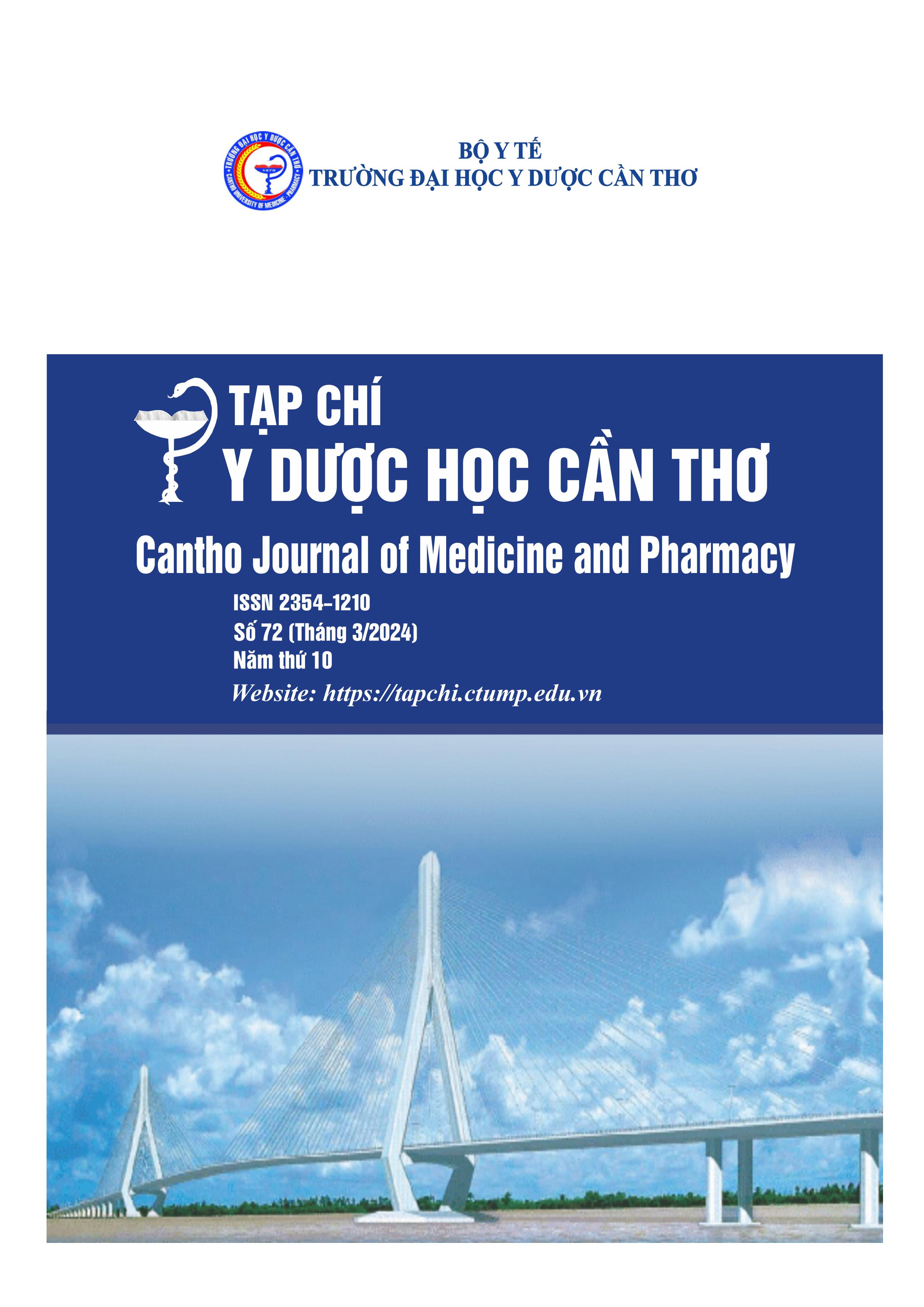TARGETING THE MICROBES THAT CAUSE PEDIATRIC ACUTE DIARRHEA: THE ROLE OF WHITE BLOOD CELLS AND C-REACTIVE PROTEIN
Main Article Content
Abstract
Background: White blood cells and C-reactive protein are biomarkers that reflect inflammation. Targeting agents causing acute diarrhea in children based on biomarkers is expected. Objectives: To determine the value of blood white blood cells, CRP, and the rate of the microbes causing acute diarrhea in children under 5 years old; to determine the relationship between white blood cells, C-reactive protein and the microbial agents. Materials and method: A cross-sectional description study was conducted on 74 children under 5 years old diagnosed with acute diarrhea at the Gastroenterology Department of Can Tho Children's Hospital from December 2022 to August 2023. Results: Virus was the main agent (41.9%), followed by bacterial-virus co-infection (21.62%), bacterial infection (18.91%), and other microbial infections (4%). The four main agents detected by Real-time polymerase chain reaction were Rotavirus group A (41.9%), Shiga toxin-producing Escherichia coli, Enterotoxigenic Escherichia coli, and Salmonella. Increased white blood cells rate accounted for 32.4%, and increased C-reactive protein rate accounted for 59.5%. There was no correlation between C-reactive protein values and blood white blood cells with groups of viral or bacterial agents causing acute diarrhea (p>0.05). Conclusion: Virus is the main agent causing acute diarrhea in children under 5 years old. White blood cells and C-reactive protein do not play a role in targeting the microbes. Therefore, microbiological diagnosis based on white blood cells and C-reactive protein in this subject should be carefully considered.
Article Details
Keywords
acute diarrhea, children, C-reactive protein, white blood cells, microbes
References
2. Phùng Thị Bích Thủy, Vũ Thị Tâm, Nguyễn Thị Thanh Phúc, Đỗ Thu Hường, Quách Thị Hoa và cộng sự. Thực trạng chẩn đoán và điều trị tiêu chảy cấp của bệnh nhân nhi tại tỉnh Lào Cai năm 2020 - 2022. Tạp chí Nhi khoa. 2023. 16(3), 30-37, https://doi.org/10.52724/tcnk.v16i3.
3. Hoang Ngoc Anh, Dang Thi Thuy Ha, and Luong Thi Nghiem. Clinical and Laboratory Characteristics of Children Hospitalized with Diarrhea at Vietnam National Children's Hospital. Journal of Pediatric Research and Practice. 2020. (3), 35-40, https://doi.org/10.25073/jprp.v4i3.204.
4. Robert M. Kliegman, Joseph W. St Geme, Nathan J. Blum, Samir S. Shah, Robert C. Tasker, et al. Reference Intervals for Laboratory Tests and Procedures. Nelson textbook of pediatrics Philadelphia, PA : Elsevier. 2020, 14797-14806.
5. Nguyễn Tiến Dũng và Nguyễn Thị Liễu. Đặc điểm lâm sàng, cận lâm sàng tiêu chảy do Rotavirus ở trẻ dưới 5 tuổi. Tạp chí Nhi khoa. 2022. 15, 25-31, https://doi.org/10.52724/tcnk.v15i4.117.
6. J.-C. Kabayiza, M.E. Andersson, S. Nilsson, C. Baribwira, G. Muhirwa, et al. Diarrhoeagenic microbes by real-time PCR in Rwandan children under 5 years of age with acute gastroenteritis. Clinical Microbiology and Infection. 2014. 20(12), 1128-1135, https://doi.org/10.1111/1469-0691.12698.
7. Nguyễn Thị Nguyên Thảo, Trần Công Lý, Nguyễn Thị Xuân Quỳnh, Lê Hoài Phong, Nguyễn Thị Bảo Duyên và cộng sự. Đặc điểm lâm sàng, cận lâm sàng và điều trị tiêu chảy cấp mất nước ở trẻ nhập viện Bệnh viện Nhi đồng Cần Thơ năm 2021-2022. Tạp chí Y Dược học Cần Thơ. 2023. 57, 57-64, https://doi.org/10.58490/ctump.2023i57.595.
8. Phạm Võ Phương Thảo. Nghiên cứu đặc điểm lâm sàng và cận lâm sàng bệnh tiêu chảy cấp ở trẻ từ 2 tháng đến 5 tuổi tại Bệnh viện Trung ương Huế. Tạp chí Y Dược Học Huế. 2021. 11(01), 24, https://www.doi.org/10.34071/jmp.2021.1.3.
9. Islam Md Shariful, Khan Chowdhury Mohammad Rocky, Bornee Farzana, Chowdhury Hasina, Billah Baki, et al. Prevalence and Determinants of Diarrhea, Fever, and Coexistence of Diarrhea and Fever in Children Under-Five in Bangladesh. Children. 2023. 10, 1829, doi:10.3390/children10111829.
10. Yoonseon Park, Minji Son, Dong Wook Jekarl, Hyun Yoo Choi, Sang Yong Kim, et al. Clinical Significance of Inflammatory Biomarkers in Acute Pediatric Diarrhea. Pediatr Gastroenterol Hepatol Nutr. 2019. 22(4), 369-376, doi:10.5223/pghn.2019.22.4.369.
11. Adam M. A., Wang J., Enan K. A., Shen H., Wang H., et al. Molecular Survey of Viral and Bacterial Causes of Childhood Diarrhea in Khartoum State, Sudan. Front Microbiol. 2018. 9, 112, doi:10.3389/fmicb.2018.00112.
12. Fares M., Mourad S., Rajab M., and Rifai N. The use of C-reactive protein in predicting bacterial co-
Infection in children with bronchiolitis. N Am J Med Sci. 2011. 3(3), 152-6, doi: 10.4297/najms.2011.3152.
13. Yin-Jiang Lv, Qi-Lei Hu, Rong Huang, Liang Zhang, Li-Feng Wu, et al. The Diagnostic and Therapeutic Value of the Detection of Serum Amyloid A and C-Reactive Protein in Infants with Rotavirus Diarrhea. Int J Gen Med. 2021. 14, 3611-3617, doi: 10.2147/ijgm.S319915.
14. Nguyen Thi Ngoc Tran. Research on Charateristics of hs-CRP, Procalcitonin, Interleukin-6 in Severe Viral Pneumonia of Children under 5 Years Old. Journal of Pediatric Research and Practice. 2021. 5(4), 11-19, https://doi.org/10.47973/jprp.v5i4.339.


